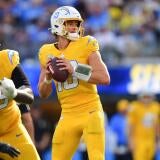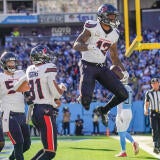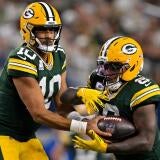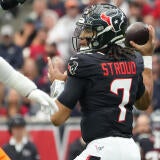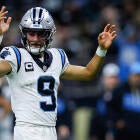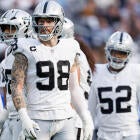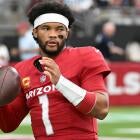Agent's Take: The definitive 2024 Super Bowl tale of the financial tape for 49ers vs. Chiefs
There's a big difference in the way the two Super Bowl 58 teams spent money to get there
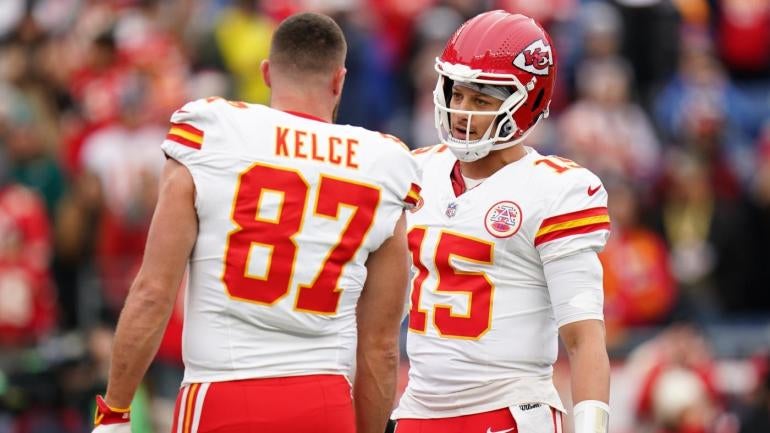
The idiom, "Different strokes for different folks" can be aptly used to describe building a championship caliber NFL roster under the salary cap. There isn't a right or wrong way to allocate resources in putting together a team that has Super Bowl potential. A specific blueprint doesn't exist.
Super Bowl LVIII between the Kansas City Chiefs and San Francisco 49ers is a good illustration of the idiom (here's how to watch the Super Bowl on CBS, Nickelodeon and Paramount+). Kansas City has gotten to the Super Bowl with a high priced quarterback. San Francisco has a low cost quarterback on a rookie contract.
The following chart outlines the salary cap charges for the Chiefs and 49ers key contributors throughout the season at each position and on special teams. That's 31 players for both the Chiefs and 49ers. The breakdown for each team is 15 on offense and 16 on defense.
Dead money, a salary cap charge for a player no longer on a team's roster, is tracked as well. The NFL collective bargaining agreement's $295 daily amount for participating in a team's voluntary offseason workout program is included in the cap numbers.
| Chiefs | 49ers | |
|---|---|---|
QB | $37,133,825 | $897,513 |
RB | $4,350,411 | $11,009,263 |
WR | $16,821,319 | $13,683,763 |
TE | $15,829,829 | $10,605,698 |
OL | $24,503,794 | $22,674,947 |
EDGE | $10,030,108 | $14,079,076 |
Interior DL | $29,931,365 | $23,639,719 |
LB | $6,266,894 | $17,399,700 |
CB | $8,041,457 | $10,542,329 |
Safety | $17,038,336 | $4,090,541 |
Special teams | $9,094,676 | $4,026,745 |
Dead money | $11,576,655 | $32,586,169 |
The NFL salary cap is currently $224.8 million. Each team's actual salary cap (known as adjusted salary cap) is typically different from the NFL's set amount because unused cap room can be carried over from one year to the next year and other adjustments can further increase or decrease cap space.
The league-wide average is $229,369,753 according to NFLPA data. The Chiefs have the NFL's lowest adjusted salary cap at $220,447,793. Situations like this typically occur when incentives earned during the previous season that weren't counting on the cap get accounted for without sufficient cap room carrying over from the prior year to make up the difference. The Chiefs had $7,174,704 of incentives to account for with $2,822,497 of cap space being carried over from the 2022 league year for a $4,352,207 deficit.
The 49ers have the league's third largest adjusted salary cap at $237,520,268. It's a function of the 49ers carrying over $5,238,795 of cap room and getting a $7,481,473 salary cap credit from incentives classified as likely to be earned not being achieved. The 49ers had the league's biggest credit relating to incentives while the Chiefs had the biggest debit.
Kansas City's key contributor cap spending skews heavily to the offense, which isn't a surprise considering the presence of a high priced quarterback. It's $98.639 million offensively to $71.308 million defensively. The 49ers are the opposite with more of the cap devoted to defense. The distribution is just under $58.871 million on offense and a $69,751,365 million for the defense.
Kansas City's three best players, defensive tackle Chris Jones, tight end Travis Kelce and quarterback Patrick Mahomes, have the biggest cap numbers on the team. Collectively, the trio count for $78,746,094 on the cap, which is 35.72% of Kansas City's adjusted salary cap.
The 49ers rank last in the NFL in 2023 cap expenditures with $201,125,002 despite one of the largest adjusted salary caps. Multiple contracts of players who are among the highest paid at their respective positions (Christian McCaffrey, George Kittle, Fred Warner and Trent Williams) were restructured to push 2023 cap obligations into the future. For example, $18.235 million of Williams' $19.4 million 2023 base salary was converted to signing bonus to create $14.588 million of 2023 cap space. $9.476 million of cap room was picked up by converting $11.845 million of Fred Warner's 2023 base salary into signing bonus. The result is the 49ers have the most cap room to carry over to the 2024 league year with $36,395,266.
Dead money
Dead money exists because of how salary cap accounting rules operate. Signing bonuses, option bonuses and certain roster bonuses are prorated or spread out evenly over the life of a contract for a maximum of five years. When a player is released, traded or retires, the remaining proration of these salary components immediately accelerate onto his team's current salary cap.
There are two major exceptions to this general rule of bonus proration accelerating. Only the current year's proration counts toward the salary cap with transactions occurring after June 1. The bonus proration in future contract years is delayed until the next league year beginning in the following March. A team can also release two players each league year prior to June 2 (known as a post-June 1 designation) that will be treated under the salary cap as if they were released after June 1. With a post-June 1 designation, a team is required to carry the player's full cap number until June 2 even though he is no longer a part of the roster. The player's salary comes off the books at that time unless it is guaranteed.
This means dead money is typically a sunk cost where money isn't owed to a player. Only if there are salary guarantees when a player is released will there be a payment associated with dead money.
The 49ers have almost three times as much dead money as the Chiefs. There are three dead money charges over $5 million. Edge rusher Dee Ford leads the way at $8,589,999 from his July 2022 release. The 49ers have $8,369,694 from trading quarterback Trey Lance, who was the third overall pick in the 2021 NFL Draft, to the Cowboys for a 2024 fourth-round pick during the preseason. Safety Jimmie Ward's 2023 through 2025 contract years that voided left a $6.395 million residual cap charge.
The Chiefs only have one dead money charge of any consequence. It's $7,604,443 from releasing edge rusher Frank Clark last March.
The 49ers have a unique cap situation. There's a big adjusted salary cap with the league's lowest cap expenditures while also having significant dead money.
Offense
Quarterback
The quarterback cap allocation couldn't be more pronounced. Kansas City's roster building was infinitely more challenging. Mahomes has the league's largest cap number at $37,133,825. San Francisco is the beneficiary of having a high caliber quarterback on a rookie contract, which is the most valuable commodity in the NFL because of the roster flexibility it can provide. Brock Purdy's $897,513 cap number is the NFL's lowest for a starting quarterback. It's why the 49ers have Sam Darnold on a one-year deal with a $6.3 million cap hit. Lance's dead money is San Francisco biggest cap charge associated with a quarterback. Mahomes' cap number accounts for almost 17% of Kansas City's adjusted salary cap while Purdy takes up only 0.38% of San Francisco's.
Running back
The 49ers have a much bigger investment in running back. McCaffrey is the NFL's highest paid running back with the four year contract extension averaging $16,015,853 per year the Carolina Panthers gave him in 2020 when he had two years left on his rookie deal. The 49ers acquired him from the Panthers for 2023 second, third and fourth round picks as well as a 2024 fifth round pick during the 2022 season as the trading deadline was approaching.
McCaffrey originally had a $12 million 2023 cap charge after the trade. It's $3.424 million because $10.72 million of McCaffrey 2023 base salary was converted to signing bonus with voiding 2026 and 2027 contract years being added in the process for proration purposes. Since all of the bonus proration from the extension remained on Carolina's books, the Panthers had $18,352,250 in 2023 dead money for McCaffrey.
Kyle Juszczyk is the NFL's highest paid fullback at $5.4 million per year. His $6,591,110 2023 cap number almost doubles McCaffrey's. Juszczyk led NFL fullbacks in offensive playtime with 46.44%.
2022 seventh round pick Isiah Pacheco ($899,217 cap number) is Kansas City's leading rusher. The bulk of Kansas City's running back cap charges come from 2020 first round pick Clyde Edwards-Helaire ($3,451,194 cap number), Pacheco's primary backup.
Wide receiver
The biggest cap charge among wide receivers belongs to Kansas City's Marquez Valdes-Scantling ($11 million cap number). He signed a three-year, $30 million deal averaging $10 million per year with $15 million of guarantees in 2022 free agency. Incentives make the maximum value of $36 million ($12 million per year). Valdes-Scantling is a potential offseason salary cap casualty after a big decrease in production from last season. He only caught 21 passes for 315 yards with one touchdown in 16 games this season. The Chiefs would pick up $12 million of cap space by letting Valdes-Scantling go. 2023 second round pick Rashee Rice ($1,183,317 cap number) emerged as Mahomes' favorite wide receiver target.
Deebo Samuel ($8,742,650 cap number) was a part of 2022's wide receiver salary explosion. The 49ers signed Samuel to a three-year, $71.55 million extension averaging $23.85 million per year with $58.167 million in guarantees where $41 million was fully guaranteed at signing. Extending Brandon Aiyuk's contract will likely be an offseason priority for the 49ers. He is scheduled to make a fully guaranteed $14.124 million in 2024 on a fifth year option. Aiyuk ($3,999,852 cap number) could get a deal comparable to Samuel's.
Tight end
Both teams have tight ends near the top of the market. Kittle and Kelce are respectively the NFL's third and fourth highest paid tight ends at $15 million and $14,312,500 per year. Kelce has the league's second highest 2023 tight end cap number at $14,801,944. Kittle had the top tight end 2023 cap hit with $18,039,356 before the 49ers lowered it to $9,542,180 through a contract restructure right before the regular season started.
Offensive line
The 49ers have one big offensive line expenditure in Williams while the Chiefs have a mix of players on both veteran and rookie contracts. Williams has been the NFL's best left tackle since signing a six-year, $138.06 million contract that made him the league's highest paid offensive lineman at $23.01 million per year. He's now third. The 35-year old isn't showing any signs of slowing down. Williams has San Francisco's biggest cap hit at $12,583,542.
The Chiefs surprisingly put Jawaan Taylor in the exclusive $20 million per offensive lineman club, which has eight members, rather than re-sign left tackle Orlando Brown, Jr., who played 2022 under a $16.662 million franchise tag. Taylor signed a four-year, $80 million contract with $60 million in guarantees, of which $40 million was fully guaranteed at signing. He was expected to make the transition to left tackle until Buccaneers castoff Donovan Smith was signed to a one-year, $3 million deal worth up to $9 million through incentives. Taylor was 2023's most penalized player according to Pro Football Reference. He was flagged 19 times.
Joe Thuney, who may miss the Super Bowl with a pectoral injury, became the NFL's highest paid offensive guard when the Chiefs signed him to a five-year, $80 million contract containing $46.89 million of guarantees in 2021 free agency. Five offensive guards have since topped him. Kansas City hit home runs in the 2021 Draft with center Creed Humphrey ($1,527,224 cap number), a second round pick, and right guard Trey Smith ($981,821 cap number), a sixth round pick.
Defense
Edge rusher
The 49ers made Nick Bosa the league's highest paid non-quarterback with a five year $170 million extension averaging $34 million per year a couple days before the regular season opener to end his holdout. Bosa's deal has non-quarterback records of $122.5 million in overall guarantees and $88 million fully guaranteed at signing. The 49ers picked up $6.849 million of 2023 cap space with the extension as Bosa's 2023 cap number went from $17.859 million to $11.01 million.
2020 second overall pick Chase Young was brought in from the Washington Commanders essentially as a short-term rental at the midseason trading deadline for a 2024 third round pick. Bosa's former Ohio State teammate is only counting $561,111 against San Francisco's cap. That's what was left of his $1.01 million 2023 base salary.
Kansas City doesn't have any consequential edge rusher cap charge except for Clark's dead money. George Karlaftis ($2,722,048) took a big step forward in his sophomore season. The 2022 first-round pick's 10.5 sacks tied for the team lead.
Interior defensive line
Both teams have devoted substantial resources to the interior of their defensive line. Chris Jones is responsible for the bulk of Kansas City's cap charges. He has the league's sixth highest cap number for this season at $26,810,325.
The Chiefs and Jones weren't in the same ballpark on a contract extension although both sides felt he should be the NFL's second highest paid interior defensive lineman. Jones' 51 day holdout came to an end without a long term deal before preparations for Kansas City's second regular season game began.
Instead, modifications were made to Jones' remaining 2023 contract year. Jones' $1.25 million sack incentive was made a part of the $5.5 million of new performance bonuses that were added as an option bonus escalator to pick up a voiding 2028 contract year. There's a provision designed to force the Chiefs to exercise the option. Voiding 2024 through 2027 contract years were also included. It was done this way because the $6.75 million would have been classified as likely to be earned incentives. Jones earned $4.25 million of the escalator.
Using a 2024 franchise tag on Jones will be pricey. Jones' franchise tag projects to $32,169,912 because of how the 120% of prior year's salary provisions work. This would easily be the largest franchise tag for a non-quarterback in league history.
Javon Hargrave ($6.595 million cap number) capitalized on a career high 11 sacks in 2022 with a $21 million per year payday in free agency despite being 30 years old. San Francisco's defensive tackle duo of Arik Armstead and Hargrave has contracts averaging a collective $38 million per year. Armstead, whose deal averages $17 million per year, has San Francisco's second largest 2023 cap number ($12,108,136).
Linebacker
Off-ball linebacker isn't a premium position. That hasn't stopped the 49ers making a significant financial investment because Fred Warner is arguably the league's best off ball linebacker. Warner was the first off-ball linebacker to hit the $19 million per year mark with the five-year extension averaging $19.045 million he received from the 49ers just before the start of training camp in 2021. His $9.049 million 2023 cap number is fifth among NFL inside linebackers. Dre Greenlaw ($5,577,970 cap number) is underpaid at $8.2 million per year. He forms one of the league's best off ball linebacker combinations with Warner.
Kansas City's best linebackers are on rookie contracts. Nick Bolton, a 2021 second round pick, and Willie Gay, a 2020 second round pick, count $1,600,542 and $1,666,352 respectively against the cap. The neck injury that kept Gay out of the AFC Championship Game may not prevent him from playing in the Super Bowl.
Cornerback
Kansas City has gone with a youth movement at cornerback ever since Charvarius Ward left for the 49ers in 2022 free agency. The four cornerbacks (Trent McDuffie, $3,189,255 cap number; L'Jarius Snead, $2,906,300 cap number; Jaylen Watson, $900,192 cap number; and Joshua Williams, $1,045,710) are on rookie contracts.
Ward ($6,423,360 cap number) is leader of San Francisco's cover men. He signed a three-year, $40.5 million contract (worth up to $42 million through incentives) with $26.62 million of guarantees to join the 49ers. Ward earned second All-Pro and Pro Bowl honors for the first time this season. Snead has put himself in position to top his former teammate Ward's deal in free agency.
Safety
Kansas City's safety cap charges more than quadruple San Francisco's primarily because of Justin Reid. Kansas City signed Reid to a three-year, $31.5 million deal with $20.485 million fully guaranteed as unrestricted free agent in 2022 to essentially replace three-time first All-Pro Tyrann Mathieu, whose contract expired after the 2021 season. Reid's has the NFL's fourth largest 2023 safety cap hit at $12.7 million.
San Francisco lost their best safety, Talanoa Hufanga ($1,007,118 cap number), to a torn right ACL in a Week 11 game against the Buccaneers. Hufanga, a 2021 fifth round pick, was a first team All-Pro last season.
Special teams
There's a big discrepancy with the special teams cap expenditures. Kansas City's are just over 125% percent more than San Francisco's. Chiefs kicker Harrison Butker's $5,128,796 cap number is $1,102,051 more than San Francisco's collective cap charges. He has the NFL's third biggest cap charge for a kicker.
The 49ers used a late third round pick to select Jake Moody ($996,746 cap number) in the 2023 Draft. He was the first of the three kickers taken.

